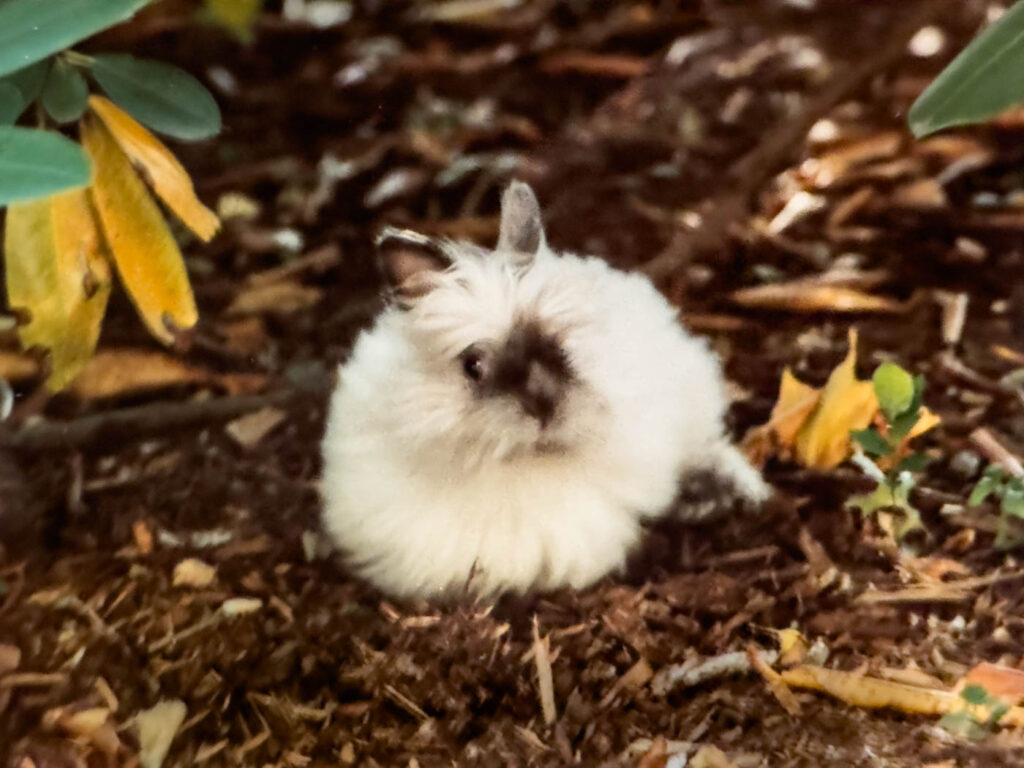Walking through the park one afternoon, you spot a rabbit. His lop-ears, or angora fur, or black and white spots, tell you that this is definitely not a wild rabbit. He’s one of the thousands of discards, tossed out to fend for himself. Or one of the thousands more who escapes from his obviously not very secure outdoor quarters in someone’s yard. You know what the future holds for [this bunny] if he stays where he is: slow death by starvation, attack by a cat, dog, raccoon, or human, infectious disease, heat, cold. The list goes on, but the bottom line is constant: you have to get him out of there. You approach him. Naturally, he bolts. Now what? Catching a rabbit who doesn’t want to be caught, as house-rabbit people everywhere have learned, is difficult enough in the confines of your own living room. Outdoors, it can be impossible. But, as a matter of life and death, it’s still worth a try. Here are a few suggestions.
One or two humans, one or two rabbits
The quickest way is to use a net. However, nets are not easy to obtain, and they require skill to use. If you’re fortunate enough to have an animal shelter or Animal Control Department with the time, staff, and willingness, they’re the ones for the job. They have the equipment and the expertise. So start your rescue using the [internet and] a phone. [Your local] Animal Control [is a part of] city or county services. If they won’t send someone, call your local humane society or SPCA. It’s possible that they can offer you some suggestions or even some person-power. If you have a local rabbit rescue group near you, they may also have some help to offer.
Don’t have Local Support?
If your requests for help leave you back where you started, your next option is to get hold of a humane trap. These can often be rented from the shelter or animal control. In many areas, you can rent them from commercial companies. Or, you can buy one with no other animal scents on it at [Amazon.com or] a hardware store. The best trap has openings at both ends, so that before it’s sprung it looks like a wire tunnel. Rabbits are less reluctant to enter if it looks like it’s got more than one way out.
Setting the Trap
Some skill is required in setting the control on the trap so that it springs at a fairly light touch from the rabbit’s foot. Practice using the controls at home until you get a sense of how they work. You can, in effect, make the trip-plate bigger by setting a piece of cardboard on top of it, and putting the bait on that. Use something with a strong, tempting (to a rabbit) aroma as bait. Bananas are a good first choice. Next would be grated carrot, as grating tends to release a stronger smell. Drape a sheet over the whole trap. This will make it less scary to enter and less stressful for the bunny once he’s inside. Place the trap in a shady, somewhat secluded spot, for the same reasons. You must check the trap at least every 4-6 hours. All your good intentions will be wasted if the rabbit dies of stress/shock from being trapped in the trap.
As you can see, humane traps are far from ideal. They require an investment in time, money, and effort. They are stressful for the rabbit, of course; but so is living outdoors, unprotected. This is rescue work at its most fundamental, and that bunny is lucky that someone has finally come along who is willing to at least try to save her life.
Making Friends
A much slower method is to make friends with the rabbit. Keep going back, as many times a day as you can, trying to get a little closer each time. This is a time-consuming task; try to enlist a friend or two to share it. When you approach her, do so crouching low and from the side. If she can see you only from one eye, her distance vision will be less acute. Sometimes a rabbit who runs from you is actually enough of a “people rabbit” that you’ll be able to get near him once he gets over his initial terror. Take treats with you – bananas, apple, carrot, lettuce, rabbit food pellets, etc. Place them on the ground, and sit quietly about 10 feet away from them. Try putting the treats into a front-opening (not top-opening) animal carrier. Attach a piece of wire to the door, so that you can push it shut from a few feet away.
If you do succeed in rescuing the rabbit, you have three new choices ahead of you. You can adopt her yourself; you can try to find a good home for her; or you can take her to the shelter, where she will either be adopted or euthanized. If at all possible, keep her at your home for at least a few days before taking her to the shelter. This will give her a chance to begin to recover from the extremely stressful experiences of living unprotected and of being trapped, which will in turn make her more adoptable.
Multiple humans, multiple rabbits
Sometimes rabbits survive abandonment long enough to reproduce. One female with one litter very soon becomes many rabbits, and it is not unusual for word of these rabbit dumping-grounds to spread. This happened in Orange County (CA), where volunteers managed to rescue about 80 rabbits from a lot in an urban area where people had been dumping them for years.
“Because rabbits are crepuscular, we’d go to work sometime between midnight and 6 AM. Sometimes we were there from midnight to 6 AM. The rabbits were normally outside their extensive burrows and tunnels at this time, foraging for food. When we tried daytime rescues we were unsuccessful unless the rabbit was very sick.”
One scenario involved hooking together three “puppy pens/x-pens.” These are sectioned enclosures used as play pens for young puppies. We’d put them in an almost closed circle, leaving an opening just big enough that the rabbits wouldn’t really notice the pen (usually 2-3 feet, larger with very nervous rabbits). Someone would sit quiet & still inside the pen and throw SMALL pieces of carrot (or, in our more desperate times, cookies or whatever would work!) toward the nosy rabbits as they approached the opening. As soon as one took the bait, the person in the enclosed area would throw another piece that landed a bit closer to her. The idea is to get the rabbit far enough into the enclosed area so that the people stationed on both sides of the opening could (depending on how wild the rabbit was) RUN or quietly and slowly walk toward each other, bringing the edges of the run together. The rabbit(s) would either panic or sit quietly while someone picked him up. Okay, that last part didn’t happen often, but it DID on occasion! In addition to the gate-closers we had one or two people there to get into the enclosure quickly and help grab the bunny so he wouldn’t hurt himself. We used cardboard top-opening carriers (disposable to prevent infection), and we put the rabbit in the carrier while he was still inside the run (we learned from experience!).
We used a slight variation of this method to trap rabbits congregated under bushes. We set up the same circle of dog exercise pens, using as many as necessary to enclose the bush(es) completely. Depending on the height of the humans and the height of the pens, we would stand either just inside or just outside the circle. As the bunnies emerged we reached in and grabbed them. This method does not work if there are burrows under the bush, as the rabbits will just wait you out, in the security of their tunnels.
Scenario 3: herding. We used this when rabbits were gathered close to a wall. After hooking 2 or 3 runs together, one person was stationed at one end of the run at the wall, with one section of the run folded against the wall, to prevent the rabbits from pushing it away. We use as many runs as necessary to give us enough distance from the rabbits so they didn’t get spooked. Then we’d walk slowly and quietly around the rabbits, unfolding the pen as we went, until we reached the wall again. The idea is to surround the rabbits using both the runs and the wall to enclose them. As soon as they were trapped in the run, we had several people ready to quickly but calmly pick up the rabbits and put them in the cardboard carriers.
A note on demeanor: when we acted nonchalant, as if we didn’t care whether the little stinkers came or went, we seemed to get more of them. When we were impatient, we didn’t get many at all. Also, we learned that stress and fear are contagious across species lines. No matter how tense we felt, we were most helpful to the animals when we kept our actions calm, our movements as quick as possible without rushing.
We didn’t use traps because we weren’t able to check them on a frequent and regular basis. Also, this rescue took place in an urban area. We didn’t want rabbits to be confined in a trap where anyone could walk by and take the trap or otherwise harm them.
We took them the very next day to the veterinary clinic. Many of them were sick with coccidiosis, and two of these died. All were spayed and neutered as soon as their health and age permitted.
Common Search Terms
- How to rescue a stray rabbit
- How to catch a stray bunny
- How to rescue a bunny running loose
- Helping a stray domestic rabbit

